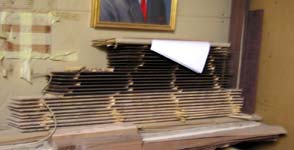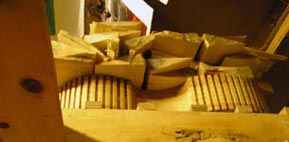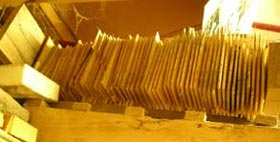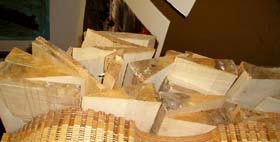This regarding the sound. Other complications arise when we take other factors that influence the whole perception of the quality of the instrument, as aesthetic attractiveness, because it is very difficult (impossible) to take apart the various effects in the sound perception (statistically
it is possible but that is another story). An anecdote on the most valuable wood for the construction of guitars back and sides: Brazilian rosewood (dalbergia nigra, beautiful, expensive wood which is every day more and more endangered and more difficult to obtain in decent quality). The use of that wood for the construction of guitars begun in Spain when it was used like valuable wood for the construction of furniture (and we all know how furniture have to play and sound well). The economic instruments (flamenco) constructed of cypress (yellowish wood, very beautiful and aromatic one that is said to have tranquilising propriety). I have lost the story, so I finish here. A suggestion for all of you that have in plan buying an instrument (from me or someone else). Play them and listen to them as much as you can.

guitar sound at least in concert settings (obviously in instruments of similar quality) in which the human ear perceives mostly variations of intensity (Seder Alojzije, 2003).
Apart the wood quality as a important factor is the type of construction (you can call it the luthers skill).
wood have some thing in common with the rose, apart the smell when freshly cut that resemble the rose flower smell. The cedar is used mainly for the guitar soundboard, classical or steel string, but someone use it also for the violin family (i do not think it is a good idea). It is much lighter than spruce, but with less strength. The soundboard made of cedar is often thicker that itís spruce cousin. Cedar is appreciated especially in concert classical guitar and because it require less time to open up. On the other side is said that the sound do not improve with time as much as spruce (maybe because of the absence of resin in the wood). As for the other differences of spruce and cedar I think that is almost mythology.
I donít like to be misunderstood, but in the production of the sound of a soundboard there are many variables and some indicators that the human perceptive system is not as perfect in detecting the difference in quality of the
For the soundboard we do not have so much choice. In use are some species of wood that have a good strength to weight ratio. The most used is, of course, spruce and red cedar (for the guitar) and redwood (also for the guitar).
If you encounter the termini rosewood,
donít think that the
music. I prefer the domestic species of wood, even if I use some exotic species (it depends on the instrument). When we speak about acoustical instruments, where the thickness of the wood is about 2-3 mm, the most important thing is that the wood is well seasoned and quartered. For the back and the sides the salient feature of the material is its hardness and aesthetic beauty (that one maybe more important than the first one). There are some local species that fit that use like maple, walnut, cherry, pear wood, olive wood, cypress... and some exotic species like rosewood (dalbergia in all his variation and subspecies), ebony, padouk, wengeí, mahagony, bubinga... and if someone know some other species you can add it to the list, which is far from being exhaustive. That is true for the construction of the guitar and related instruments. The main material for the construction of the violin and similar instruments is maple.
Wood. Simple, complex, natural, warm, soft and hard at the same time. A guy that have bought a guitar have said that I have forgotten to mention the smell of the wood, so... (now come to mind the smell of cypress wood. Try it). The material that best combines with the warmness of



